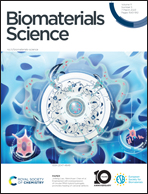A simple and programmable dual-mode aptasensor for the ultrasensitive detection of multidrug-resistant bacteria†
Abstract
Accurately identifying multidrug-resistant (MDR) bacteria from clinical samples has long been a challenge. Herein, we report a simple and programmable dual-mode aptasensor called DAPT to reliably detect MDR bacteria. The DAPT method comprises two elements, namely the mode of dynamic light scattering (Mode-DLS) for ultrasensitive detection and the mode of fluorescence (Mode-Flu) for reliable quantification as a potent complement. Benefiting from the states of aptamer-modified gold nanoparticles (AptGNPs) sensitively changing from dispersion to aggregation, the proposed Mode-DLS achieved the rapid, specific, and ultrasensitive detection of methicillin-resistant Staphylococcus aureus (MRSA) at the limit of detection (LOD) of 4.63 CFU mL−1 in a proof-of-concept experiment. Simultaneously, the Mode-Flu ensured the accuracy of the detection, especially at a high concentration of bacteria. Moreover, the feasibility and universality of the DAPT platform was validated with four other superbugs by simply reprogramming the corresponding sequence. Overall, the proposed DAPT method based on a dual-mode aptasensor can provide a universal platform for the rapid and ultrasensitive detection of pathogenic bacteria due to its superior programmability.



 Please wait while we load your content...
Please wait while we load your content...